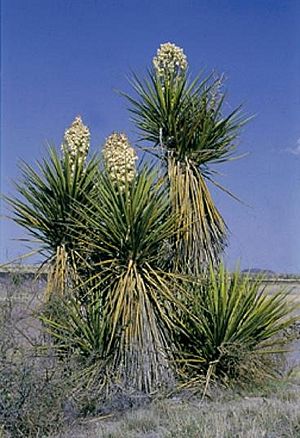Faxon yucca facts for kids
Yucca faxoniana is a cool plant that looks like a giant, spiky shrub. It's an evergreen plant, meaning its leaves stay green all year round. This plant is part of the Yucca family and is famous for its sharp, blade-like leaves. You might hear it called Faxon yucca, Spanish dagger, or giant dagger.
Quick facts for kids Spanish dagger |
|
|---|---|
 |
|
| Blooming, in Chihuahuan Desert habitat. | |
| Scientific classification | |
| Synonyms | |
|
Contents
What Does the Spanish Dagger Look Like?
This plant usually grows as a shrub with many trunks. It can be about 3 to 10 feet (1 to 3 meters) tall. Sometimes, it has just one trunk and can grow like a tree, reaching up to 20 feet (6 meters) high!
Its leaves are long and blade-shaped. They can be anywhere from 2 to 4.5 feet (0.6 to 1.4 meters) long. The flowers are a beautiful ivory or creamy white color. They are shaped like bells and grow on a flower stalk that can be up to 2 feet (0.6 meters) long.
How Does It Reproduce?
The Spanish dagger's flowers are pollinated by special moths. These moths belong to a group called Tegeticula. The flowers usually bloom in April. After blooming, the plant grows sweet, soft, oval-shaped fruits.
Naming the Spanish Dagger
For a while, this plant was called Yucca torreyi. This name was given in 1908 by a person named John Adolph Shafer. He named it after John Torrey, an American botanist from the 1800s. Torrey was the first to describe this plant as a new type in 1859.
Today, Y. torreyi is not considered the correct name. Scientists now use either Yucca treculeana or Y. faxoniana as the proper scientific name.
Where Does the Spanish Dagger Grow?
The Yucca faxoniana plant naturally grows in the Chihuahuan Desert. This desert region is found in northern Mexico, southern New Mexico, and southwestern Texas.
It is most common around Big Bend National Park. This park is located in the central Rio Grande valley, right in the heart of the Chihuahuan Desert. You can find it mainly in the Mexican states of Chihuahua and Coahuila. It also grows in smaller areas of Durango and Nuevo León. However, it does not grow in the northern part of the Rio Grande Basin in central New Mexico. It also isn't found in the lowest part of the Rio Grande Valley, closer to the Gulf of Mexico.
How People Used This Plant
Long ago, Native Americans used the fruit of the Spanish dagger as food. They would eat it fresh, roast it, or dry it and grind it into a flour-like meal.
They also used the strong leaves of the plant. The fibers from the leaves were used to make many useful things. These included baskets, cloth, mats, ropes, and even sandals! The roots of the plant were special too. They were used to create red patterns in baskets made by the Apache people.
See also
 In Spanish: Yucca faxoniana para niños
In Spanish: Yucca faxoniana para niños

